To use the preview of presentations, create yourself a Google account (account) and log in: https://accounts.google.com
Slide captions:
Lesson Theme: Cellular Structure of the Leaf
We answer orally the questions: What is a sheet? What functions does the sheet perform? Which leaves are called petiolate and which are sessile? How are simple leaves different from complex? What is a vein? What types of venation do you know? What venation is characteristic of monocotyledonous plants, give examples? What venation is characteristic of dicotyledonous plants, give examples? Slide Work Identify complex and simple leaves. Identify venation of leaves. Performing a test on the options Recall the material of the last lesson:
Identify simple and complex leaves. Sign them Define and sign types of leaf venation
Answers to the first option: 1) b; 2) a; 3) b; 4) b; 5) c. Answers to the second option: 1) in; 2) b; 3) a; 4) a; 5) a. We will crosscheck the test:
We got acquainted with the external structure of the leaves. Today we will get acquainted with the internal structure of the leaves. Attention to the question: why is the study of the microscopic structure of the sheet necessary and important?
To study the structure of the peel of the sheet; To study the structure of the pulp of the leaf; To study the structure of leaf veins. Today we will continue to study the sheet, get acquainted with the internal (microscopic) structure of the sheet. We have three tasks before us:
Questions to the class: Let's remember what structure does the plant cell have? Why are the leaves green? To study the microscopic structure of green leaves, we first use the text of the textbook p. 37, and then the microscope. We read the article “The structure of the skin”, consider Fig. 29 and consider a cross section of a camellia leaf under a microscope.
On the micropreparation we find a cross-sectional drawing of a camellia leaf. The top and bottom of the sheet is covered with skin.
Tell us how the peel is arranged? What fabric is it formed? What very important skin formation is shown? What functions does it perform? Locate the intercellular spaces on the micropreparation. What is their significance?
The stomata (stomatal apparatus) consists of two green closure cells, since the closure cells contain chloroplasts. The main function of stomata is the process of water evaporation by a plant, which is called transpiration. Transpiration is based on the physical process of evaporation. The transpiration rate is controlled by stomata. Attention question: the condition and number of stomata depends on the ratio of various factors. Think which ones? We will read the article “The structure of the pulp of a leaf” p. 38, consider fig. 30 and once again examine the transverse section of a camellia leaf under a microscope.
The second question of our lesson is the structure of the pulp of the leaf. Now we will get acquainted with the structure of leaf pulp cells.
Using the image on the micropreparation and rice. 30 on page 39 of the textbook, explain the structure of the pulp cells (main tissue) of the leaf. Pay attention to the number of chloroplasts in the cells of columnar and spongy tissues. What caused this?
We read the article “The structure of leaf veins” p. 38-39, consider Fig. 30 and answer the following questions: What is a vein? What structure do veins have? What functions does the vein perform in connection with the structure? The third question of our lesson is the structure of the veins.
What structure do leaf skin cells have? What function do they perform? What is the structure of stomata trailing cells? What is the function of the stomata? What is the structure of the cells of the columnar tissue? What is the role of intercellular spaces? What is the role of veins? What we learned today in the lesson:
The sheet is covered on top ... .. On the underside of the sheet are located ... .. The flesh of the sheet consists of ... .. Veins consist of ... .. What kind of tissue vessels and sieve tubes are formed ... .. Supplement the sentences:
The main function of the leaf is photosynthesis; Photosynthesis occurs in the skin; The stomata are mainly on the upper side of the skin; The pulp of the sheet is formed by columnar and spongy tissue; Veins are conducting bundles of a leaf; Solutions of organic substances move through the vessels. Choose the correct statements:
Homework: p-f7, complete task number 29 in a workbook.
Escape is the aerial part of the plant. The vegetative shoot is laid in the process of development of the embryo in which it is represented by the kidney. A kidney is a stalk and leaf beginnings that can be considered the first kidney of a plant.
A bud is an embryonic shoot; new shoots grow from it in the spring. There are apical, axillary, (located in the axils of the leaves) and adnexal kidneys. The adnexa are formed due to the activity of the cambium and other educational tissues in different places - on the roots, stems, leaves. The section of the stem from which the leaf leaves and the kidney is called a node. The section of the stem between adjacent nodes is the internode.
The axial part of the kidney is a short rudimentary stem, on it are the rudimentary leaves. In the sinuses of the rudimentary leaves, small buds of buds can be found. A vegetative shoot develops from a vegetative bud, and a generative shoot with the rudiments of a flower or inflorescence develops from a generative bud. There are kidneys bare and protected by leathery scales.
Sheet
Leaf is a flat lateral shoot organ.
The external structure of the sheet
. In dicotyledonous plants, the leaf consists of a flat expanded plate and a stem-shaped petiole with stipules. The leaves of monocotyledonous plants are characterized by the absence of petioles, the base of the leaf, they have expanded, in the vagina, covering the stem. In cereals, the entire internode is covered with a vagina: Leaves of dicotyledonous plants are simple and complex. Simple leaves have one leaf blade, sometimes strongly dissected into lobes. Complex leaves have several leaf blades with pronounced cuttings. Cirrus leaves have an axial petiole, on both sides of which leaflets are located. Palmate leaves have leaflets that fan out from the top of the main petiole. 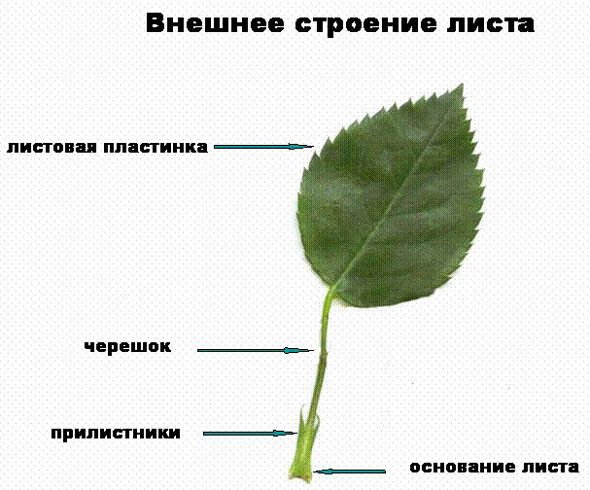
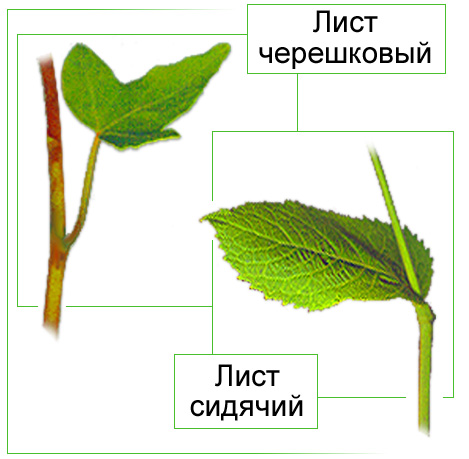
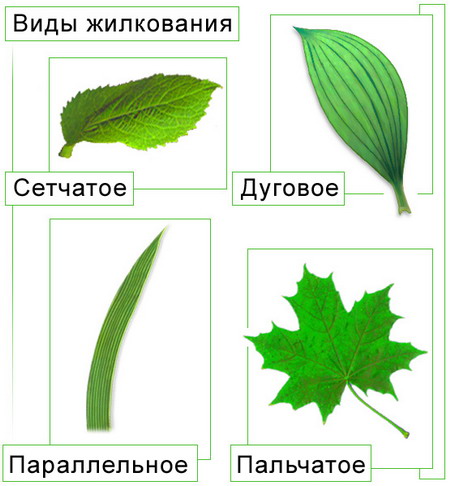
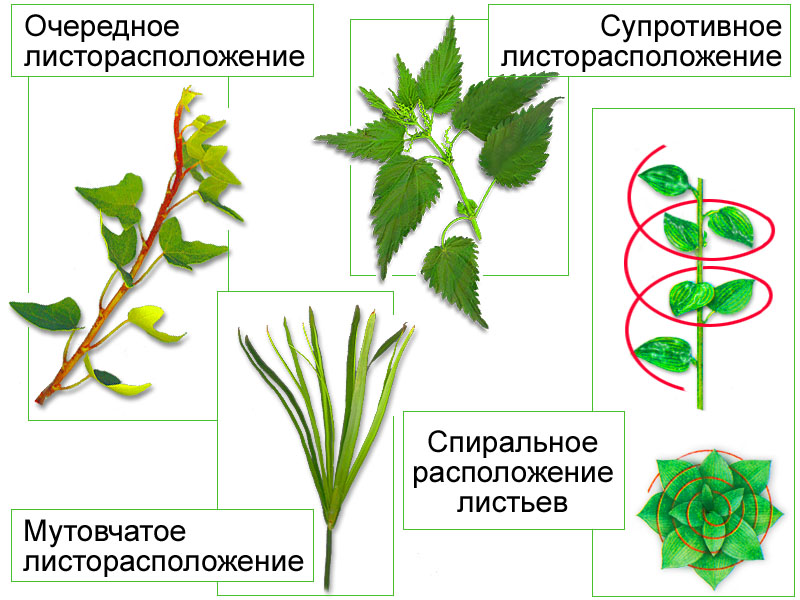
The internal structure of the sheet.
Outside the sheet is a skin of colorless cells coated with a wax-like substance - a cuticle. Under the skin are columnar parenchyma cells (palisade tissue) containing chlorophyll. The cells of the spongy parenchyma with intercellular spaces filled with air are deeper. The vessels of the conducting bundle are located in the parenchyma. On the lower surface of the leaves, the peel has stomatal cells involved in the evaporation of water. Water evaporation occurs to prevent overheating of the leaf through the stomata of the epidermis (skin). This process is called transpiration and provides a constant flow of water from the roots to the leaves. The transpiration rate depends on air humidity, temperature, light, etc. Under the influence of these factors, the turgor of the closing stomata cells changes, they close or close, delaying or enhancing the evaporation of water and gas exchange. In the process of gas exchange, oxygen is supplied to the cells for respiration or is released into the atmosphere during photosynthesis. 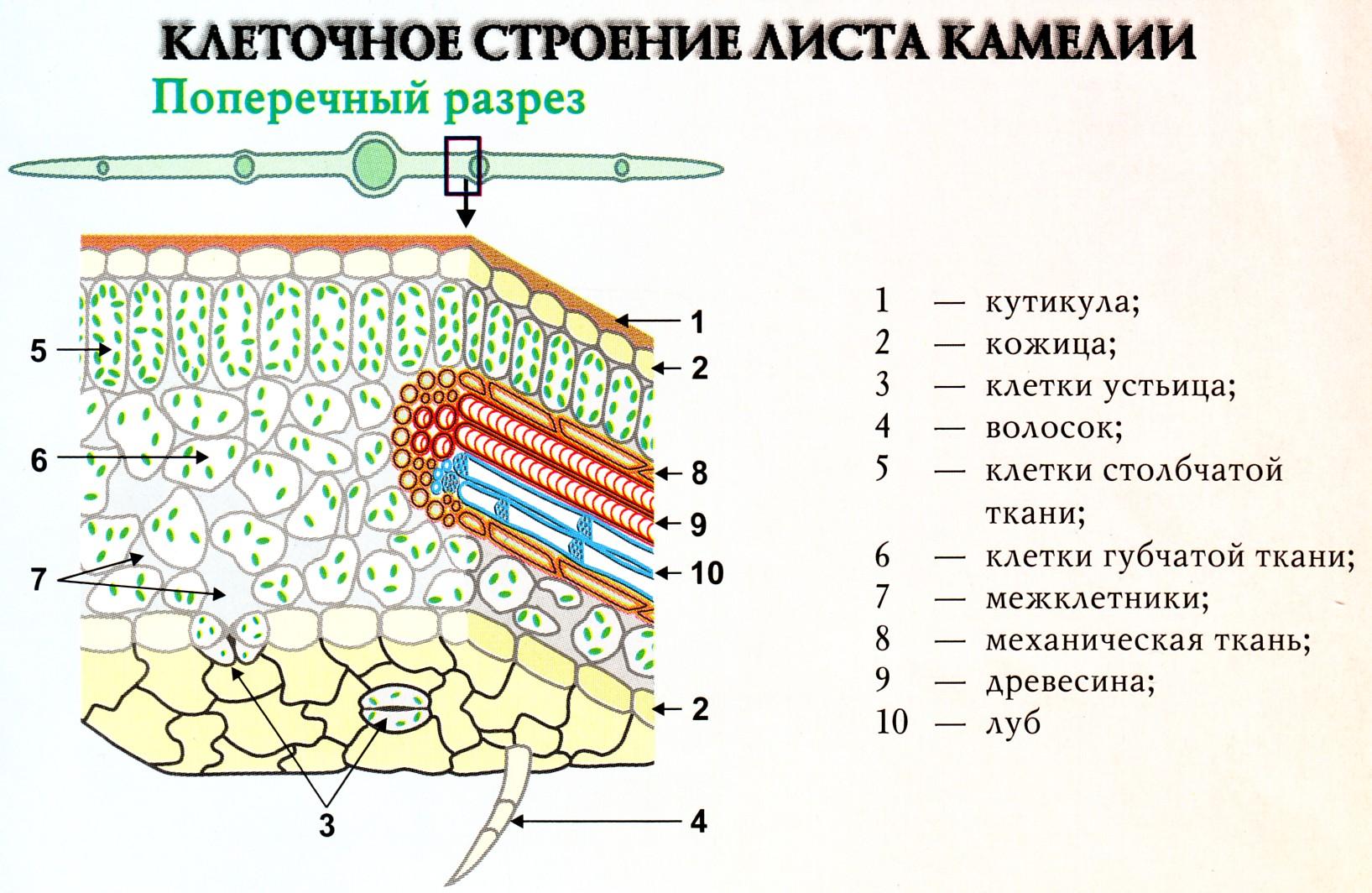
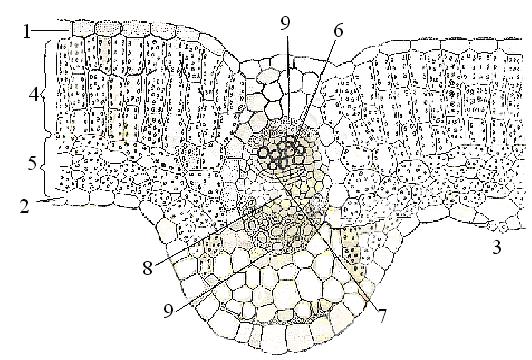
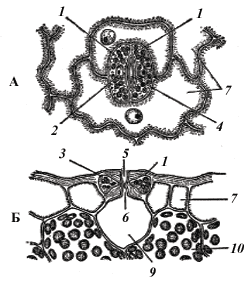
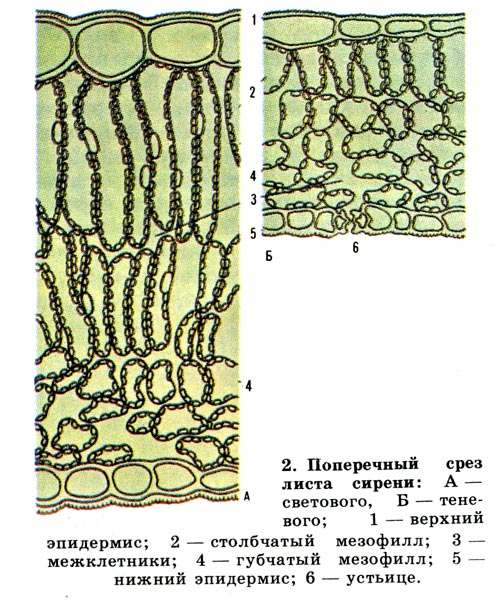
Cell structure of the leaf
Piece of sheet | cells | tissue | the functions |
Peel of the leaf (epidermis) | Cells are transparent, fit tightly together The stomatal apparatus consists of: A) paired bean-shaped closure cells B) stomatal gap between them | coverslip | Physical Protection Protection against bacteria and drying out Transmits sunlight Evaporation Gas exchange |
Leaf pulp | 1) columnar (palisade) tissue consists of green cells tightly adjacent to each other 2_ spongy tissue consists of loosely located cells between which there are intercellular spaces | Basic, photosynthetic | Photosynthesis Photosynthesis Gas exchange transpiration |
Leaf veins are conductive bundles | 1) Vessels are dead cells 2) Sieve tubes are living cells with openings in the form of sieves 3) Fibers are dead elongated cells with sharp ends, with lignified membranes | Conductive Conductive mechanical | Immune substances conduct water from bottom to top Conduct organic matter from top to bottom Give the sheet flexibility and strength, elasticity |
Leaf modifications:
antennae - serve to fix the stem in an upright position; needles (in a cactus) play a protective role;
flakes - small leaves that have lost their photosynthetic function;
trapping apparatus - the leaves are equipped with columnar glands that secrete mucus, which is used to capture small insects that have fallen on the leaf.
spines
In order to better understand the importance of green leaves in plant life, we will get acquainted with the internal structure of the leaf blade.
Leaf blade consists of a huge number of cellsthat differ in shape, size and function.
On the upper and lower sides of the sheet is covered with tight-fitting cells. it skin cells, which covers the sheet and protects it from drying out and damage. The peel is a variety integumentary tissue. The skin cells are colorless and transparent. Outside, the skin is often coated with a layer of wax-like substances that form cuticle. The cuticle gives the sheet extra strength.
Among the skin cells are located stomata. They consist of arranged in pairs green trailing cells. Their cytoplasm contains green plastids - chloroplasts. Between them is stomatal fissure.
![]()
Through the stomatal fissure in the leaf carbon dioxide penetrates and oxygen and water are released into the atmosphere. When the sheet is illuminated in the chloroplasts of the closing cells carbohydrates are formed, osmotic pressure and turgor increase. The cell walls are stretched, the stomatal gap is increased. With increased evaporation of water on a hot day and the absence of photosynthesis, turgor decreases and stomatal fissure closes. The stomata are also closed in the dark.

In plants that live on land, stomata are on the underside of the leaf or on both sides of it. In aquatic plants with leaves floating on the water, stomata are located only on the upper side of the leaf.
Under the skin are leaf pulp cells. The pulp of the leaf consists of main tissue, or parenchyma, which is located in several layers. One of the layers adjoins the upper skin. Its cells contain many chloroplasts, fit tightly together and remind columns. Therefore, the upper part of the main tissue of the leaf is called columnar parenchyma. Below are more rounded and irregularly shaped cells. it spongy parenchyma. Her cells are loose against each other. They contain fewer chloroplasts than in the cells of the columnar parenchyma. The spaces between the cells are called intercellular spaces. They are filled with air.
The veins are clearly visible in the leaf blade. Veins - These are conductive bundles of the sheet. They are most prominent on the underside of the sheet. They consist of vessels, sieve tubes and fibers. Vessels conduct minerals into leaf tissue. Sieve tubes unlike blood vessels, they are formed by living long cells. Solutions of organic substances move along sieve tubes from leaves. Strongly elongated cells with thick walls - fiber- give the sheet strength.
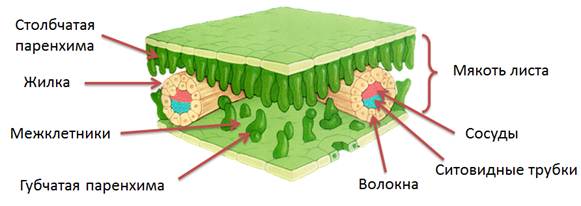
Biology lesson in grade 6. "___" ________________ 20_____
The cell structure of the leaf.
Goal. To contribute to the formation of the cellular structure of the leaf; create conditions for the formation of skills to determine the relationship of the structure of the sheet with the function performed.
Educational. To give students an idea of \u200b\u200bthe cellular structure of the leaf; show the dependence of the structure of leaves on growing conditions.
Developing. Develop the ability to work with the information received, analyze, compare, draw conclusions; establish causal relationships.
Educational. ; cultivate an interest in nature, an aesthetic feeling.
Expected Results.
Subject.
Students will learn: the structure and functions of the leaf peel, the role of stomata in plant life, the structure of stomata, the peculiarity of the structure of columnar tissue, the characteristic features of spongy tissue, the structure of conductive bundles of leaf veins; define concepts: “leaf peel”, “stomata”, “chloroplasts”, “columnar leaf tissue”, “spongy leaf tissue”, “leaf flesh”, “conductive bundle”, “vessels”, “sieve tubes”, “fibers” , "Light leaves," "shadow leaves."
Students learn how to: identify and explain the patterns of dependence of the cellular structure of the leaf on the environment.
Meta-subject.
Cognitive UUD: to form the ability to analyze and evaluate information; possess the ability to adequately use speech means for discussion and argumentation of their position, to form the ability to build logical reasoning; to form the ability to master semantic reading.
Communicative UUD: to form the ability to independently organize educational interaction when working in a group (pair); listen to a friend and substantiate your opinion; express your thoughts and ideas.
Regulatory UUD: to form the ability to independently detect and shape the educational problem, to determine the purpose of the educational activity (wording of the lesson);
to form the ability in dialogue with the teacher to improve independently developed evaluation criteria; express your thoughts and ideas.
Personal.
The manifestation of a responsible attitude to learning, the willingness to cooperate with comrades in the process of mastering knowledge, the development of sustainable cognitive interests.
During the classes.
Org moment.
Actualization of knowledge.
Frontal survey.
What is a leaf?
What functions does the sheet perform?
How are simple leaves different from complex?
How can venation determine the affiliation of a plant to monocotyledonous or dicotyledonous?
Individual work.
Biological dictation. (slide2)
1. A ground organ that captures sunlight.
2. The flattened part of the sheet.
3. The narrow stem-like part of the leaf.
4. Leaves that have one leaf blade.
5. Venation of leaves, in which the veins are parallel to one another.
6. Venation of leaves, in which the veins branch many times and form a continuous network.
7. Leaves with several leaf blades on a common petiole.
From the proposed objects, select the leaves: (slide 3)
A) complex
B) with a petiole
C) with parallel venation
D) a simple sheet
D) a simple sheet with a mesh venation
E) arc venation
G) without petiole.
Learning a new topic.
In the last lesson, we talked about the appearance and structure of the leaves. But what about the leaf inside?
What does it consist of?
A leaf, like any organ in a plant, is made up of cells. And today in the lesson we will dive into the secrets of the structure and functioning of the leaves.
Do you think all leaf cells are the same? (Leaf cells vary in shape and size).
What is the reason for the difference in the shape and size of leaf cells? (This is due to the difference in the functions performed).
What are the names of groups of cells that are similar in structure and function? (the cloth)
Independent work with the textbook p. 37.
Students fill out a table of the first four columns. (slide 4)
The cell structure of the leaf.
| The name of the part of the sheet | Type of fabric | Cell structure | Note. (teacher comment) |
|
| (slide5) | Coverslip | Thin transparent cells | Protects the sheet from damage and drying. | The top and bottom of the sheet is covered with a thin transparent skin . Some plants may also have cuticle. Cuticle - This is a protective film of a waxy, fat-like substance cutin. The cuticle protects the leaves from sunburn and strong evaporation. |
| The stomata consist of 2 closing cells, between which there is a stomatal gap. | Air enters the sheet and water evaporates. | The stomata are usually located on the lower part of the leaf, in aquatic plants - on the upper, in leaves arranged vertically - on both sides. |
||
| Leaf pulp (slide6) (slide7) | Main | Columnar - columns of the same size. Spongy - round or irregularly shaped cells that do not fit tightly together. | Photosynthesis | The structure of the leaf depends on the conditions in which the plant grows. Lighted spots are small sheet plates. Shaded areas are large but thin and delicate. In photophilous columnar cells are arranged in several rows, a lot of stomata. Shade-tolerant columnar cells have few, or none at all, large chloroplasts, many chlorophyll. |
| Leaf veins (slide 8) | Mechanical | Fibers - elongated cells with thick walls | Give strength | Conductive beams are surrounded by mechanical fabric, giving them elasticity and strength. |
| Conductive | Vessels - consist of non-living cells with destroyed membranes in places of contact with each other. | The movement of water and minerals. |
||
| Sieve tubes - living long cells, transverse septa penetrated by narrow channels | Organic matter movement |
Physical education.
We are tired, we’ve sat up
We wanted to stretch ourselves.
We put down notebooks,
We started charging (One hand up, the other down, jerkily change hands)
They looked at the wall
Then they looked through the window.
Right, left, turn,
And then vice versa (body turns)
Squats start
Bend your legs to the end.
Up and down, up and down
Do not rush to squat! (Squats)
And the last time we sat down,
And now they sat down at their desks. (Children sit down)
Primary consolidation of knowledge.
Laboratory work “Cell structure of a leaf” (p. 39) (slide 9)
Objective: to study the features of the internal structure of the sheet.
Equipment: microscope, micropreparations "Geranium Leaf", "Camellia Leaf"
1. Examine finished micropreparations for sheet shear. Locate the cells of the upper and lower skin, stomata.
2. Examine leaf pulp cells. What shape do they have? How are they located?
3. Locate the intercellular spaces on the micropreparation. What is their significance?
4. Find conductive sheet bundles? What cells are they formed? What functions do they perform? Compare micropreparations with drawing of the textbook.
5. Draw a cross section of the sheet and make all the necessary signatures.
Choose one correct answer.
1. Leaf veins:
A. Give the sheet strength
B. Conduct nutrient solutions
B. Perform photosynthesis
D. Conduct nutrient solutions and give the sheet strength
2. The peel of the sheet is the fabric:
A. Pokrovna
B. Mechanical
B. Conducting
G. Stocking
3. Conductive leaf bundles are composed of tissue cells:
A. Mechanical
B. Conducting
B. Mechanical and conductive
G. Stocking
4. The light sheet, in contrast to the shadow:
A. Has a lighter color
B. Contains less chlorophyll
B. Has several layers of columnar cells
D. All statements are true.
5. Set the correspondence between the leaves of the plants and the location of the stomata on the leaf blade.
Plants Location of stomata
1. Birch leaf A. The stomata is on the underside of the leaf.
2. Leaf water lilies B. Ustitsa absent
3. The water leaf of the arrowhead B. The stomata are on the upper side of the leaf
Summarizing. Reflection.
Homework.§ 7
Photosynthesis is the process of the formation of organic substances from carbon dioxide and water in the light with the participation of photosynthetic pigments (chlorophyll in plants, bacteriochlorophyll and bacteriorhodopsin in bacteria).
Leaf structure closely related to its functioning. The sheet consists of 3 layers
Top and bottom, the sheet is covered with a transparent skin (see Fig. 1), which protects it from damage and drying.
Fig. 1. Leaf peel
The peel (epidermis) is one of the types of integumentary tissue of the plant. Usually consists of 1 layer of cells. Its cells secrete a wax-like cuticle, which covers the surface of the sheet, protects the sheet from the evaporation of water (transpiration).
Among the skin cells contain trailing cells, the cytoplasm of which contains chloroplasts. There is a gap between the cells. These formations are called stomata (see Fig. 2).
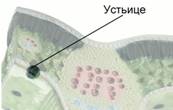
Fig. 2. Ustitsa
Stomata perform the functions of gas exchange and water evaporation. Stomatal cells are able to close, preventing the excessive evaporation of water. The movements of stomatal cells depend on the water availability of the plant, illumination, and temperature.
Plastidsare membrane organoids found in photosynthetic eukaryotic organisms (higher plants, lower algae, some unicellular organisms). Plastids are surrounded by two membranes, their matrix has its own genomic system, the functions of plastids are associated with the energy supply of the cell, which goes to the needs of photosynthesis.
The stomata are mainly located on the inside of the leaf. In floating leaves of aquatic plants, stomata are located only on the upper side of the leaf. Underwater leaves of aquatic plants have no stomata.
The lower layer of the epidermis often has hairs that reduce overheating of the plant and reduce the degree of transpiration.
On 1 mm 2 leaf surface of stomata from 50 to 500 pieces.
Peel structure
Take a leaf of geranium. Break it and with a dissecting needle remove a piece of the skin. Prepare the preparation, examine it under the microscope (see Fig. 3).
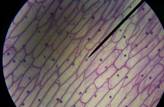
Fig. 3. The preparation of the peel of a geranium leaf
Find colorless cells, describe them. Find stomatal cells, indicate their difference from other cells of the skin of the leaf. Draw the skin of the sheet, make the signature.
Parenchyma- the flesh of the leaf, consists of cells of the main tissue.
At the top is a columnar parenchyma (see Fig. 4), formed by columnar cells. They have many chloroplasts, the main photosynthetic leaf cells.
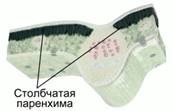
Fig. 4. Column parenchyma cells
Below is the spongy parenchyma (see Fig. 5). It consists of irregularly shaped cells that are not tightly adjacent to each other. Few chloroplasts. The intercellular spaces are filled with air. Cells of the spongy parenchyma carry out intensive effective gas exchange.
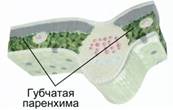
Fig. 5. Cells of the spongy parenchyma
Gas exchange in biology is the absorption and release of gas, especially oxygen and carbon dioxide, in living organisms. It involves inhaling oxygen and exhaling carbon dioxide. In plants, algae, and bacteria that carry out photosynthesis, the opposite process can occur when carbon dioxide is inhaled and pure oxygen is exhaled.
Veins (see Fig. 6) - conductive sheet bundles. Consist of vessels, sieve tubes and fibers.
Fibers - strongly elongated cells with thick walls. Give the sheet strength.
The vessels transport minerals from the roots to the leaves. They are made up of dead cells.
Sieve tubes are made up of living cells, through which solutions of organic substances move from leaves.
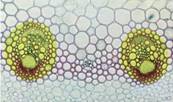
Fig. 6. Veins of a leaf, micropreparation
Cell structure of the leaf
Examine the finished micropreparations for the cross section of the sheet. Examine leaf skin cells, find stomata. Examine leaf parenchyma cells. Describe their location, shape. Consider the intercellular spaces, remember their purpose. Find the conducting bundles of the leaf, indicate the cells that form them, their functions. Compare the type of micropreparation with the picture (see. Fig. 7).
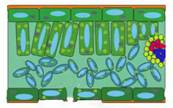
Fig. 7. Scheme of the cellular structure of the leaf
Draw a cross section of the sheet, sign all its parts and types of cells.
Experiment
Place 2 onions in jars of water so that it touches their base. Put the jars in a cool place. Put one jar in a lit place, and the other in a dark. Watch the development of leaves on the bulbs. How is it different? Why?
Bibliography
- Biology. Bacteria, fungi, plants. 6 cl .: textbook. for general education. institutions / V.V. Beekeeper. - 14th ed., Stereotype. - M .: Drofa, 2011 .-- 304 p .: ill.
- Tikhonova E.T., Romanova N.I. Biology, 6. - M.: Russian word.
- Isaeva T.A., Romanova N.I. Biology, 6. - M.: Russian word.
- Biolicey2vrn.ucoz.ru ().
- Engschool18.ru ().
- Kaz-ekzams.ru ().
Homework
- Biology. Bacteria, fungi, plants. 6 cl .: textbook. for general education. institutions / V.V. Beekeeper. - 14th ed., Stereotype. - M .: Drofa, 2011 .-- 304 p .: ill. - from. 119, assignments and questions 2, 5 ().
- How do stomatal cells function? What is their function?
- How are leaf veins arranged?
- * Imagine that the skin cells suddenly disappeared from the leaves. What will happen to them?
